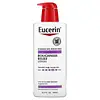What's inside
What's inside
 Key Ingredients
Key Ingredients

 Benefits
Benefits

 Concerns
Concerns

 Ingredients Side-by-side
Ingredients Side-by-side

Water
Skin ConditioningUrea
BufferingGlycerin
HumectantIsopropyl Stearate
EmollientDicaprylyl Ether
EmollientGlyceryl Glucoside
HumectantSodium Lactate
BufferingButyrospermum Parkii Butter
Skin ConditioningNylon-12
Polyglyceryl-4 Diisostearate/Polyhydroxystearate/Sebacate
EmulsifyingCetearyl Alcohol
EmollientArginine Hcl
Skin ConditioningSodium PCA
HumectantLactic Acid
BufferingCarnitine
CleansingMannitol
HumectantSerine
MaskingSucrose
HumectantCitrulline
Skin ConditioningGlycogen
HumectantHistidine Hcl
Skin ConditioningCeramide 3
Skin ConditioningAlanine
MaskingThreonine
Glutamic Acid
HumectantLysine Hcl
Skin ConditioningSodium Chloride
Masking1,2-Hexanediol
Skin ConditioningPhenoxyethanol
PreservativePotassium Sorbate
PreservativeWater, Urea, Glycerin, Isopropyl Stearate, Dicaprylyl Ether, Glyceryl Glucoside, Sodium Lactate, Butyrospermum Parkii Butter, Nylon-12, Polyglyceryl-4 Diisostearate/Polyhydroxystearate/Sebacate, Cetearyl Alcohol, Arginine Hcl, Sodium PCA, Lactic Acid, Carnitine, Mannitol, Serine, Sucrose, Citrulline, Glycogen, Histidine Hcl, Ceramide 3, Alanine, Threonine, Glutamic Acid, Lysine Hcl, Sodium Chloride, 1,2-Hexanediol, Phenoxyethanol, Potassium Sorbate
Water
Skin ConditioningCarthamus Tinctorius Seed Oil
MaskingCetyl Alcohol
EmollientStearyl Alcohol
EmollientGlycerin
HumectantButyrospermum Parkii Butter Extract
Skin ConditioningButylene Glycol
HumectantGlyceryl Stearate
EmollientPEG-100 Stearate
Dimethicone
EmollientPersea Gratissima Oil
Skin ConditioningSimmondsia Chinensis Seed Oil
EmollientCeramide AP
Skin ConditioningCeramide NP
Skin ConditioningCeramide EOP
Skin ConditioningSqualane
EmollientCholesterol
EmollientAllantoin
Skin ConditioningTocopherol
AntioxidantVitis Vinifera Seed Oil
EmollientCamellia Oleifera Leaf Extract
AstringentEpilobium Angustifolium Extract
Skin ConditioningHydrolyzed Acacia Macrostachya Seed Extract
Skin ConditioningPhytosphingosine
Skin ConditioningMyristoyl Tripeptide-31
Skin ConditioningLecithin
EmollientPanthenol
Skin ConditioningHydrogenated Lecithin
EmulsifyingCaprylyl Caprylate/Caprate
EmollientEthylhexyl Olivate
Skin ConditioningLactic Acid
BufferingCyclohexasiloxane
EmollientCyclopentasiloxane
EmollientCellulose Gum
Emulsion StabilisingMaltodextrin
AbsorbentSodium Lauroyl Lactylate
EmulsifyingSodium Hydroxide
BufferingAcrylates/C10-30 Alkyl Acrylate Crosspolymer
Emulsion StabilisingXanthan Gum
EmulsifyingCarbomer
Emulsion StabilisingBehenyl Alcohol
EmollientMyristyl Alcohol
EmollientLauryl Alcohol
EmollientArachidyl Alcohol
EmollientPhenoxyethanol
PreservativeBenzoic Acid
MaskingDehydroacetic Acid
PreservativeWater, Carthamus Tinctorius Seed Oil, Cetyl Alcohol, Stearyl Alcohol, Glycerin, Butyrospermum Parkii Butter Extract, Butylene Glycol, Glyceryl Stearate, PEG-100 Stearate, Dimethicone, Persea Gratissima Oil, Simmondsia Chinensis Seed Oil, Ceramide AP, Ceramide NP, Ceramide EOP, Squalane, Cholesterol, Allantoin, Tocopherol, Vitis Vinifera Seed Oil, Camellia Oleifera Leaf Extract, Epilobium Angustifolium Extract, Hydrolyzed Acacia Macrostachya Seed Extract, Phytosphingosine, Myristoyl Tripeptide-31, Lecithin, Panthenol, Hydrogenated Lecithin, Caprylyl Caprylate/Caprate, Ethylhexyl Olivate, Lactic Acid, Cyclohexasiloxane, Cyclopentasiloxane, Cellulose Gum, Maltodextrin, Sodium Lauroyl Lactylate, Sodium Hydroxide, Acrylates/C10-30 Alkyl Acrylate Crosspolymer, Xanthan Gum, Carbomer, Behenyl Alcohol, Myristyl Alcohol, Lauryl Alcohol, Arachidyl Alcohol, Phenoxyethanol, Benzoic Acid, Dehydroacetic Acid
 Reviews
Reviews

Ingredients Explained
These ingredients are found in both products.
Ingredients higher up in an ingredient list are typically present in a larger amount.
Glycerin is already naturally found in your skin. It helps moisturize and protect your skin.
A study from 2016 found glycerin to be more effective as a humectant than AHAs and hyaluronic acid.
As a humectant, it helps the skin stay hydrated by pulling moisture to your skin. The low molecular weight of glycerin allows it to pull moisture into the deeper layers of your skin.
Hydrated skin improves your skin barrier; Your skin barrier helps protect against irritants and bacteria.
Glycerin has also been found to have antimicrobial and antiviral properties. Due to these properties, glycerin is often used in wound and burn treatments.
In cosmetics, glycerin is usually derived from plants such as soybean or palm. However, it can also be sourced from animals, such as tallow or animal fat.
This ingredient is organic, colorless, odorless, and non-toxic.
Glycerin is the name for this ingredient in American English. British English uses Glycerol/Glycerine.
Learn more about GlycerinLactic Acid is another well-loved alpha hydroxy acid (AHA). It is gentler than glycolic acid but still highly effective.
Its main role is to exfoliate the surface of the skin by loosening the “glue” that holds dead skin cells together. Shedding those old cells leads to smoother, softer, and more even-toned skin.
Because lactic acid molecules are larger than glycolic acid, they don’t penetrate as deeply. This means they’re less likely to sting or irritate, making it a great choice for beginners or those with sensitive skin.
Like glycolic acid, it can:
Lactic acid also acts as a humectant (like hyaluronic acid). It can draw water into the skin to improve hydration and also plays a role in the skin's natural moisturizing factor (NMF) in the form of sodium lactate.
Studies show it can boost ceramide production to strengthen the skin barrier and even help balance the skin’s microbiome.
To get results, choose products with a pH between 3-4.
Lower strengths (5-12%) focus on surface exfoliation; higher strengths (12% and up) can reach deeper in the dermis (deeper, supportive layer) to improve skin texture and firmness over time.
Though it was originally derived from milk, most modern lactic acid used in skincare is vegan. It is made through non-dairy fermentation to create a bio-identical and stable form suitable for all formulations.
When lactic acid shows up near the end of an ingredient list, it usually means the brand added just a tiny amount to adjust the product’s pH.
Legend has it that Cleopatra used to bathe in sour milk to help reduce wrinkles.
Lactic acid is truly a gentle multitasker: it exfoliates, hydrates, strengthens, and brightens. It's a great ingredient for giving your skin a smooth, glowing, and healthy look without the harshness of stronger acids.
Read more about some other popular AHA's here:
Learn more about Lactic AcidPhenoxyethanol is a preservative that has germicide, antimicrobial, and aromatic properties. Studies show that phenoxyethanol can prevent microbial growth. By itself, it has a scent that is similar to that of a rose.
It's often used in formulations along with Caprylyl Glycol to preserve the shelf life of products.
Water. It's the most common cosmetic ingredient of all. You'll usually see it at the top of ingredient lists, meaning that it makes up the largest part of the product.
So why is it so popular? Water most often acts as a solvent - this means that it helps dissolve other ingredients into the formulation.
You'll also recognize water as that liquid we all need to stay alive. If you see this, drink a glass of water. Stay hydrated!
Learn more about Water